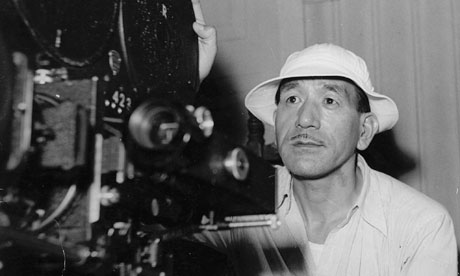
Adam Mars-Jones's new book, which arrives less than a year after his novel Cedilla, is an attempt to save postwar Japanese cinema from its reputation as a museum of mystical objects, a body of work so "hushed, serene and inexplicit" that the only sensible, even possible, response is to keep your mouth shut and bow. His favourite among these films, Yasujiro Ozu's domestic drama Late Spring (1949), has been discussed almost solely in terms of Japaneseness. But this is not a contribution to the study of "orientalism", a term that, as formulated by Edward Said (and critically parsed by Mars-Jones), "reduces all the ways in which cultures can misunderstand each other to mechanisms of control". The villains of Noriko Smiling aren't those who patronise Ozu, or overlook him, but who admire him in the wrong way.
"Sometimes, works of art need to be defended against their advocates," writes Mars-Jones, for whom attack is the best mode of defence. Donald Richie, the leading western authority on Japanese cinema, and the screenwriter Paul Schrader, who wrote a book about "transcendental style" in cinema, are given a tough ride for their readings of Ozu: "Schrader takes the Zen note struck by Richie and runs with it – in fact running doesn't do justice to his athleticism." Richie may have been responsible for western audiences' exposure to Ozu, but this "vindicated championing" has allowed him a stranglehold on his reputation.
Mars-Jones, in taking on the specialists, is open about his ignorance ("I can hardly be accused of being an expert on Japanese film"; "I don't pretend to be an expert on Japanese family structure", "I'm not claiming any actual knowledge of the layout of Tokyo"). Since the purpose of his book is to offer a fresh perspective, his outsider status can only be an advantage. His eyes are open and receptive, rather than blinded by familiarity: censorship of Japanese cinema during the American occupation, while "not exactly a secret", is "something that people keep on forgetting to mention"; the popularity, during the silent era, of the narrator-explainer or benshi shows that Japanese audiences, rather than fetishising implication, had always "wanted things spelled out". Taking on the widely held view that Ozu was indifferent to history, "except as it impinges on family relations", he demonstrates that, in telling the story of a 27-year-old woman who is gradually persuaded into marriage, Ozu was alive to, and touched by, history of various kinds. Without seeking to replace Ozu's taste for "inner unity" with an equally static image of, say, Ozu the sociologist, he scrutinises the film for moments in which everyday reality makes its presence felt, or rather seen and heard. The film's opening scene is a case in point: the heroine Noriko (Setsuko Hara) is in traditional dress, "naturally enough (culturally enough)", but she's also holding a handbag. For Mars-Jones, the film isn't in retreat from history so much as a reckoning with it, but such as acknowledgement carries its dangers too. Confronting a critic who sees Ozu as a traditionalist disgusted by western ways but prevented by censorship from saying so, he writes: "After all we've been through, I'm not going to let Late Spring be turned into a sort of coded gazetteer of nostalgic militarism."
Mars-Jones acknowledges that there's a certain amount of adjustment necessary if we're to have any understanding of Japanese cinema, that watching an Ozu film is not the same as watching a George Cukor film with subtitles and a foreign setting; but critics who treat Ozu's work as ungraspably alien ("wholly enclosed by Japanese art, which is wholly enclosed by Zen aesthetics") are letting themselves off the hook. "Common sense," being a relative concept, isn't much help, but dialectical reason might be. It is Mars-Jones's habit to confront, and resolve, sources of potential discord between Japanese cinema and Western viewers, presenting Ozu's disregard for continuity editing as neither imperceptible nor totally disruptive, but akin to a printing error: "Audiences rapidly work out what was 'meant', and then forget that there was ever any doubt." Noriko Smiling, which comes without chapters or even subheads, is published by an imprint "devoted to the best in essay writing". If an essay is, in Dr Johnson's phrase, a loose sally of the mind, then this is about as loose as they come – but what a mind! Mars-Jones writes as well about Ozu's style, his "strategic management of effects", as he does about the legibility of human impulses, both those of real people (Ozu, Kurosawa) and invented characters (Noriko, her father, her friend Aya, her aunt Masha).
And yet despite his ethical seriousness, Mars-Jones's tone is talkative, at times even flippant. The effect is not to undermine his insights but to ground them. This book stands as a reproach to Ozu's awestruck champions.

